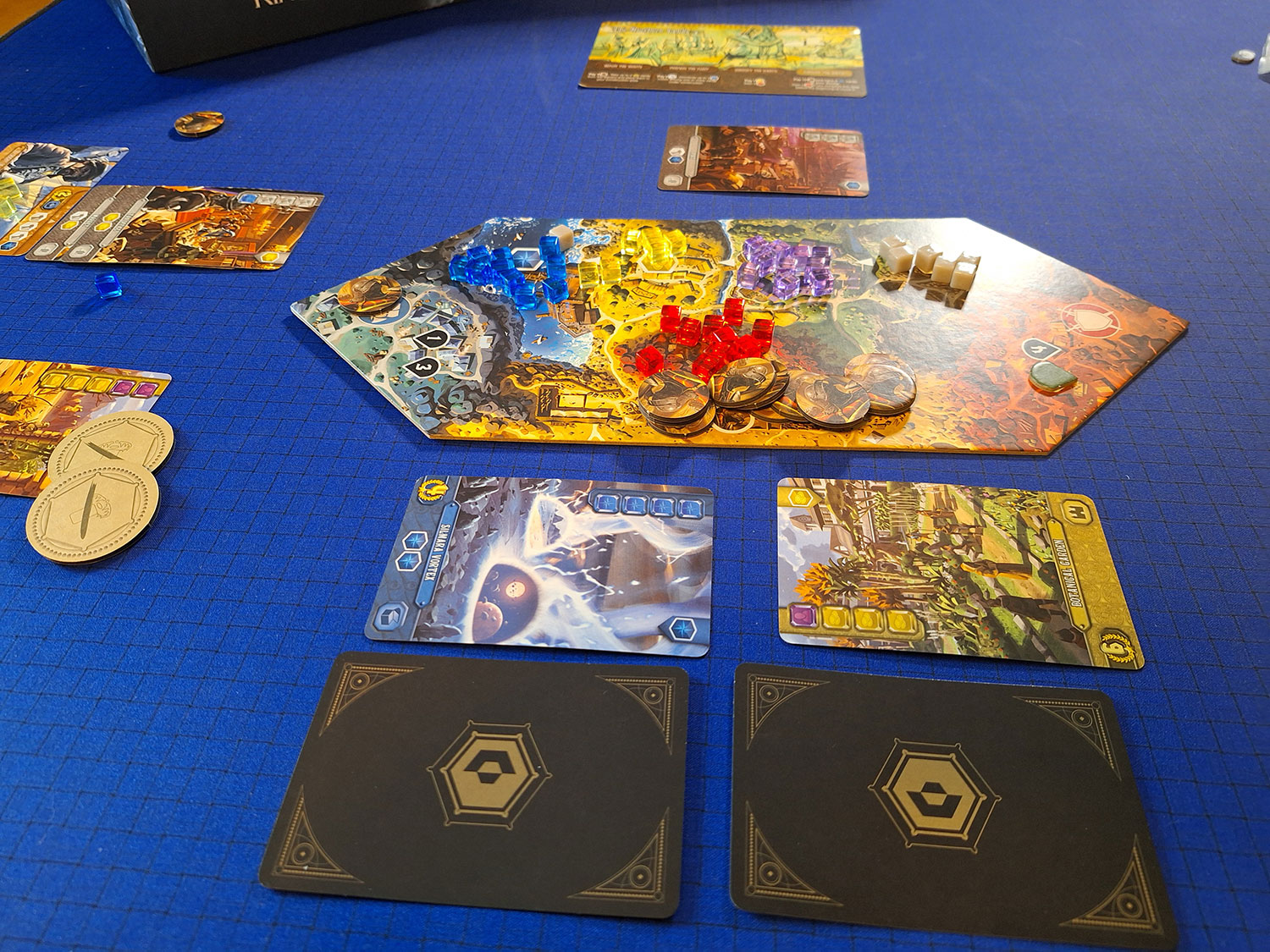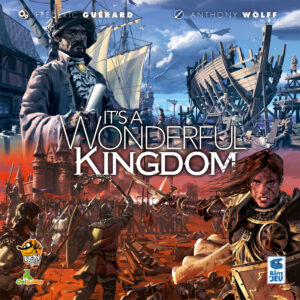 The original implementation of this game, It’s a Wonderful World, was popular with our gaming group a few years ago, so I was pleased to try out the new 2-player game. The game group loved the original because it was a quick yet satisfying play, with light strategy and a bit of interaction during the blind card drafting.
The original implementation of this game, It’s a Wonderful World, was popular with our gaming group a few years ago, so I was pleased to try out the new 2-player game. The game group loved the original because it was a quick yet satisfying play, with light strategy and a bit of interaction during the blind card drafting.
Although there are several significant changes, the resource collection and tableau building mechanics in It’s a Wonderful Kingdom are alike, keeping the essence of the original. It’s a Wonderful Kingdom adds module overlays and a new card selection process. Card selection is now “you cut, I choose” with a brutal bluffing element.
It’s a Wonderful Kingdom from La Boite de Jeu is designed by Frederic Guerard with art by Anthony Wolff. It is designed for 1 or 2 players and plays in 30-45 minutes.
Gameplay Overview:
The game is played in 4 rounds of three phases each. In the choice phase, you pick up development cards which, when built, provide resources, end game points, or both. In the planning phase, you decide whether to slate a card for construction or recycle it for a single resource.
In the production phase, your starting duchy card and any constructed cards produce resources, which allow you to continue constructing development cards. Like its predecessor, producing the most resources of one type gains you a benefit. In Wonderful Kingdom, you gain soldiers, which you’ll need to advance in the modules.

During the choice phase, starting with a hand of 7 development cards and 1 calamity card, the first player offers two face-up cards, placed in one of two offering areas. You may distribute them across the two areas or place them both in either area. The second player then takes all the cards from a single offering area before making their own offering, following the same rule. Unchosen cards accumulate in the offering areas as each player picks up one offering and lays down two more cards for their opponent to choose from. This method of card selection means players may end the choice phase with different size hands.
Each player has two trap tokens which they may use during the choice phase to place a card in their offer face-down.
One of the three included modules must be chosen for each game. Two modules have a special deck that is added to the development deck. Each module has additional rules and objectives. The menace module adds a combat phase where any menace cards you’ve acquired must be vanquished. The advisor module includes advisors who give you special abilities you may pay to use during different phases of a round. The quest module adds a board with special tasks you must complete to win the game, regardless of points you’ve obtained.
At the end of four rounds, end game points are totaled, which may include: negative points for calamity cards, victory points on constructed cards and variable points on certain cards for set collection of card types.

Game Experience:
Aside from the card selection, there are no deep difficulties in gameplay. Yet once again, It’s a Wonderful Kingdom gives you a steadily expanding tableau, increasing your resource production round by round until you are swimming in resources.
Choosing your cards from the offerings is tricky. The trap tokens make it less likely that you’ll get a great hand because any good development card probably comes with a face-down card that is likely a calamity card.

Sometimes the offering areas become wildly unbalanced, as players avoid what they expect to be a pile-up of negative point cards. This might pay off, because the final unselected offering is discarded, but it results in far fewer cards in hand at the end of the phase.
Once the choice phase ends, the game proceeds smoothly.
The modules are meant to add more than flavor; they present new challenges or obstacles beyond expanding your kingdom. They didn’t seem to change the feel of the game, but simply added a layer of difficulty or minor special abilities. In other words, the modules feel more like distractions than extensions to the gameplay.
Final Thoughts:
A fun re-imagining of It’s a Wonderful World, a fast, satisfying play, with a great bluffing feature in the card selection phase of the game. The modules in It’s a Wonderful Kingdom do not add much to the enjoyment of the game, although they add complexity to decision-making.
Final Score: 3 Stars – Quick and enjoyable gameplay, yet with little strategy beyond the bluffing mechanism during card selection.
 Hits:
Hits:
• Trap tokens
• You Cut, I Choose card selection
Misses:
• The modules play like unnecessary distractions from the essential game.
Source: Board Game Quest





